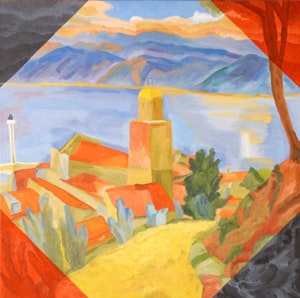“Lot 106 Basilica and Lighthouse, St Tropez [BC020] 1930 is a luminous oil painting from this period. Adopting a high viewpoint and eliminating unnecessary detail, Scales reduces the forms of the village to a series of interlocking planes of colour.
It was works like Basilica and Lighthouse, St Tropez that so impressed the young Toss Woollaston when Scales returned to Nelson. ‘I have been to see Miss Scales’, he wrote to his friend Rodney Kennedy in 1934, ‘I am agog.’1
1 Undated letter [May 1934] in Toss Woollaston: A Life in Letters, ed. Jill Trevelyan, Te Papa Press, 2004, p.38."




